

|

|
Layouts
Copper River & Northwestern Railway
Jan 14, 2003


By Ronald N Simpson |
Author
Bio
The story behind the 1:24 model of the Copper River & Northwestern Railway--Chitina Local at the Copper Rail Depot, Copper Center, South Central Alaska
|

A CRNW combination passenger and baggage coach after railroad abandonment | It would be difficult to pick a date or even a year that marks the true origin of my historically-based model railroad. But it was born as part of a photo research project dating back to 1989 when I began taking a strong interest in a copper company ghost town called Kennecott. |
The locality is now a famous ghost town. It was built along a steep hillside just above the Kennicott Glacier on the southern slopes of the Wrangell Range in south central Alaska.

Kennecott at Track Grade, CRNW mile 196 | Kennecott Copper Company derived its name from the place of its origin, which was this remote place deep within the territory of Alaska. |
When the discovery of a massive copper lode known as the Bonanza was confirmed, a group of east-coast investors formed something known then as the Alaska Syndicate which in 1915 evolved into the Kennecott Corporation. The investors required a railroad to access their claims. Construction of the Copper River & Northwestern Railway--a standard gauge common carrier--began in 1908 at Eyak, which became known as Cordova. The line reached Bonanza in March 1911. By 1915 this mill town was known as Kennecott.

Kennecott--Bonanza Ridge in background | The 196-mile line followed the Copper River a distance of 131 railroad miles to Chitina. This was to be the mainline which would continue on up the Copper River, ultimately crossing the Alaska Range and terminating at Chena Landing near what became Fairbanks. |
That was the mainline, which ran east from Cordova to CRNW mile 50, then north to Chitina, mile 131. The branch to the copper mines was to leave the mainline at Chitina, cross the Copper River in an easterly direction and continue another 65 miles until it finally terminated at the mill town. For political reasons the mainline never was extended north of Chitina in the direction of Copper Center, so the Chitina Local branch became by default the only extension of the Cordova mainline.

Railroad Terminal--Cordova Wharf, CRNW Mile 0 | The railroad builders anticipated that the mine would produce for about eight years. For this reason, much of the railroad was built on temporary trestles rather than permanent steel bridges. |
In fact fully fifteen percent of the first 131 miles of the line was built upon trestles. The roster included five Dickson saddle tanks used during construction, one 1881 Rogers, three ALCO-Brooks moguls weighing 80 tons, and four Rhode Island consolidation engines of about 85 tons. Between 1915 and 1917 five 95-ton Brooks mikados were added for pulling the increasingly heavy loads as the mine continued to produce increasingly greater tonnages of copper.

A Mikado engine at Kennecott | The line also had eight open-ended 55 foot coaches and about 250 freight cars. The ore was carried on 107 steel flat cars in burlap bags that contained processed copper ore. Maintenance equipment included four massive rotary snow plows to handle the enormous snow drifts which were common in the first 100 miles of the line. |
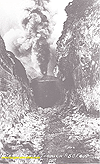
CRNW rotary snowplow going through 50-foot trench | The Kennecott Mines started with the Bonanza, then the Jumbo and finally the Mother Lode. Two smaller mines--the Erie and Glacier were developed as well. All of these sent ore to the 14-story Kennecott mill by means to two aerial trams of about 3 miles each that connected the back of the mill to the Bonanza and the Jumbo Mines--nearly 4,000 feet in elevation above Kennecott. |

Ruins of the Jumbo mine about 4,000 feet above Kennecott | Chitina at mile 131 was the first real town beyond Cordova. All the others in that distance were nothing more than whistle stops with mostly long-forgotten names such as Tiekel, Bremner, Cascade, Baird, Moraine, Uranatina, Katalla Junction, Flag Point and Goat Mountain. |

Bremner--a whistle stop at CRNW mile 78 | It was 60 miles from Chitina to McCarthy, the only other real town on the line. Both communities averaged about 200 people, but had businesses built to serve much larger towns because these two locations serviced extensive gold and copper mine districts. |
Chitina had a circular turn-around enabling the trains easily return to Cordova from Chitina. It also had a two-bay locomotive repair barn and facilities for a sizeable railroad maintenance crew. The town had three large hotels, but the main street was only two blocks long.

A passenger consist at the Chitina CRNW Railway depot | McCarthy had a turn table. The engines were reversed at McCarthy, then backed the remaining 5 miles into Kennecott because no room existed at the end of the line to allow for turning the engines around. |
McCarthy also had a two-bay locomotive repair barn and two blocks which consisted of the downtown area. Both towns marked the beginnings of the two most significant grades on the line. The grade past Chitina was over 6 miles long, with the first part being a steep four percent rise. The McCarthy to Kennecott grade averaged about 3 1/2 per cent. The railroad yards at both towns included a pusher locomotive--usually one of the moguls--for assisting heavy trains heading toward Kennecott.

CRNW Railway buildings at McCarthy | The Kennecott mines proved to contain the richest high-grade copper ore veins ever discovered--ultimately exceeding in production value the entire output of the richest of Alaska's gold mines and even that of the each of the gold districts, and even the Klondike gold fields which produced 192 million in gold between 1885 and 1908. |
Only the Juneau gold district out-produced this one group of copper mines. In the end, Kennecott took out 207 million dollars in copper. When the underground mines were finally exhausted in 1938, the mines, Kennecott mill town, McCarthy, Chitina, and the entire railroad were all abandoned.

CRNW passenger consist at the end of the project | Today the Kennecott mill site exists as a ghost town within a national park and McCarthy and Chitina have been revived. McCarthy is a tourist destination while Chitina regained some of the original Ahtna Indian population and is known for its Copper River salmon dip-netting. The rail bed which was the Chitina Local was converted into a road that still connects McCarthy to Chitina. |

Historic downtown McCarthy | It is this region which I chose in modeling my large-scale railroad. Utilizing the hundreds of photos I eventually obtained from years of research, largely from the archives at the University of Alaska in Fairbanks, I began the process of constructing some of the major buildings from the old days of the CRNW Railway. Many of these buildings no longer exist. Most of those that I chose to model were impressive in their construction style and size. |
Most notable of these was the Kennecott mill itself. The historic mill has somehow survived into modern times. The version my father and I built was as it existed in 1920. My team and I also built much of the town around that mill as it existed in the 1920s. This includes the 200-foot long power plant--which still exists, a 130-foot barrack--which does not--and the hospital, two management cottages, the office, the engineers' staff house, the machine shop and a warehouse.

The hospital, engineers' staff house, and mill building models | All of these buildings are 1/4 inch plywood construction with 1/8 inch plex for windows. I placed the interior floors and walls in all the buildings and wired them for lighting using salvaged 6-volt pinball light holders and transformers. This feature is a throw-back from the days when I owned a coin-operated amusement company. The system works remarkably well. |
In most cases I had to make a best-guess as to the interior floor plan. Only in a few cases have floor plans survived. Where I have had access to such plans, I have been enabled to re-create a near-exact duplication of the original structure. In a limited number of cases, I was even able to measure and photograph existing buildings, but most of the model really does consist of long-gone structures.
At the same time I constructed two of the most interesting Chitina structures--the railroad depot and the two-story Hotel Chitina. Both of these are long-gone. These were built entirely with the use of photos for reference.

Chitina depot and water tower | My team also built a section of one of the more famous of the wooden trestles--the 880-foot, curved Gilahina trestle. Part of the original trestle still stands about 30 miles east of Chitina along the McCarthy Road. The model duplicates the center section, which was about 80 feet tall. |

Gilahina trestle model | When I began construction of these large structures I chose a scale based on a Bachman ten-wheeler which someone gave me. I had never seen a G-scale model before. I liked the looks and size of that one engine so much that I knew right away that this was the scale I wanted to use. It turns out that 1:24 scale is a particularly easy one to draw, so that is the scale I have used since I started with the first model back in 1995. |

The mixed-freight consist model enters the outdoor area | The Kennecott structures were completed by 1998 with the construction of the large power plant, machine shop, and the Bonanza barracks. By then I had found an existing bar business about 160 miles south of where I lived at the time. Copper Center Bar is a long way from my old home in Fairbanks, but it is about 50 road miles from Chitina. |
Once I made the decision to purchase that business, I began the process of planning to build an overhead large-scale model railroad within the bar building. The track is a combination of LGB and Aristocraft brass. All the locomotives are powered by nicad batteries and operated remotely.

McCarthy railroad yard model | I had built up a large collection of framed historic photos of Kennecott and its CRNW Railway, including many interesting historic panoramics, which I hung in the bar. I began building overhead supports for indoor track in 1998. In 1999 the model railroad finally ran for the first time. Some of the model rolling stock was now four years old. |
It soon became apparent that the interior of the bar was not sufficiently large to house the entire model that I contemplated. I began plans for the 36-foot long building needed to house the Kennecott part of the model. In the interim my small crew was building a large, fenced yard that would serve as a beer garden and the home of the overhead model railroad once I had extended it outdoors. By the end of 2000 the building was complete and the mill model was installed. This model had sat in the wanigan part of the trailer I had been living in for two years. It took up a great amount of my home space. I was greatly relieved to have a new and permanent home for this enormous model.

The mill model in its new permanent location in the year 2000. | The next year I brought in the carpenter who had assisted in construction of some of the larger model buildings. He had just relocated his residence from Fairbanks, Alaska to Spokane, Washington, so I had to provide the plane ticket and expenses, not to mention a considerable fee for services, but that cost was well worth it. |
We then began construction of the elevated walkway that was necessary to properly view the Kennecott part of the model. At the same time we started work on the construction of the overhead rail bed. By the end of May, about 120 feet of outdoor track connected the bar building to the one which housed the model mill town. The bar contained the Chitina depot and Hotel Chitina.

The building which houses the Kennecott model | Just outside the bar I had a 4-span steel bridge built following plans I obtained for the one which should have crossed the Copper River at Chitina. That one had never been built because, as I already noted, the railroad was only built to last eight years. The crossing at Chitina was a 950-foot wooden trestle which washed out each year at spring breakup. |

Copper River trestle crossing near Chitina, CRNW mile 132 | The company did not want to spend the estimated $650,000 it would cost to build the permanent 4-span one which would also be built in such a way as to eliminate the worst part of the steep grade on the east side of the Copper River. Now that bridge exists so all can see what could have been. |

A section of the Copper River steel bridge crossing | I had left room along the outdoor rail line for the building of the town of McCarthy. This year my help and I constructed catwalks to access the outdoor track which is about 10 feet above the ground. We then placed roofing over much of the track to protect the structures we were about to build. Toward the end of the summer we began building historic downtown McCarthy. This included some very large structures that no longer exist. We completed the downtown area and the railroad yard in about two months. |

View of outdoor railway--looking toward McCarthy | As a final touch to this model I decided to build one of the actual mine sites. You will recall that the mines themselves were separated from the mill site by 3 miles of aerial tram lines and by about 4,000 feet of elevation. The mine site I chose to model was the Mother Lode--ML--a 75-man camp which opened in 1913 and continued in use until 1927. |

| This camp was completely destroyed by an avalanche while the mine was in operation and has never been viewed by anyone still living. Using existing photos, I drew up the plans that have now become the reality of a model copper mine camp that is about 12 feet in actual length and 4 feet wide. |
This group of mine structure models was installed in the building which houses the Kennecott mill model on November 20 on a day when it reached 30 above. For the two previous weeks the temperatures rarely reached above 10, so we got the rare temperature break we needed to place the ML in its intended final location, thus placing the final touches on a very elaborate historic railroad and mining model.

The Mother Lode upper camp | A full history of the railroad and Kennecott mines exists in the form of a historic novel I wrote a year ago--"Sorry: this link is no longer available from source. Legacy of the Chief" |
I chose to write a novel rather than a history because it is much more interesting and readable and it allowed me to use speculation where the known history leaves only gaps. The novel does, however, include about 250 full page historic photos over its 800 pages. Central to the book is the story of the destruction of Mother Lode by avalanche.
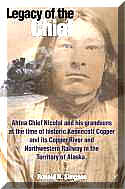
| What authenticates this story even more than my thousands of hours of research is that I, through my grandmother, am a member of the Nicolai family, which includes Skolai Nicolai, the Ahtna Athabascan chief who first revealed the existence of the massive copper lodes which quickly led to the formation of Kennecott and its railroad. |
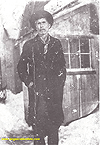
Skolai Nicolai, "tyone of Taral"--the Ahtna Chief who started it all | Appropriately, the book is the Native tale of the Copper River & Northwestern Railway, but it contains extensive details regarding the operation of the mines and railroad and it follows the known history very closely. It has been quite an experience to reproduce this great piece of American and Alaskan history. |
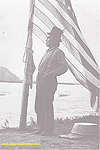
Ahtna clan head Doc Billum and Old Glory at the Copper River | None of these models would have ever been built without considerable assistance. While I designed and oversaw the building of all of these historic structures, several other gifted and highly dedicated people, including my father, were involved in the re-creation of this great piece of railroad Americana. |

The track plan, 1999 | When I purchased the bar, it was with the idea that I would be installing the model and photo collection within it. At the time of purchase I already had created plans for the interior track. I did not then contemplate that the model would extend outside. This model was not built for any purpose other than the sheer joy of re-creating history, but it is beginning to turn into quite a tourist attraction. |
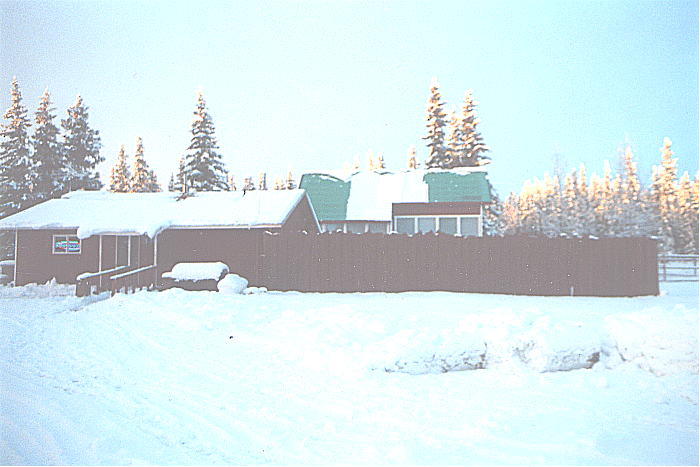
The Copper Rail Depot--Copper Center Bar--in winter | The website I designed for this project can be found at http://crnwrailway.com
and I encourage all who have read this article to consider visiting Alaska to see what is undoubtedly one of the most unique large-scale model railroads ever constructed. |
Top of Page
|
|

|
IMPORTANT LINKS
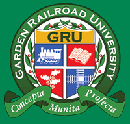
Get Your Official Diploma

Watch New Videos


New Products Online
|
|



